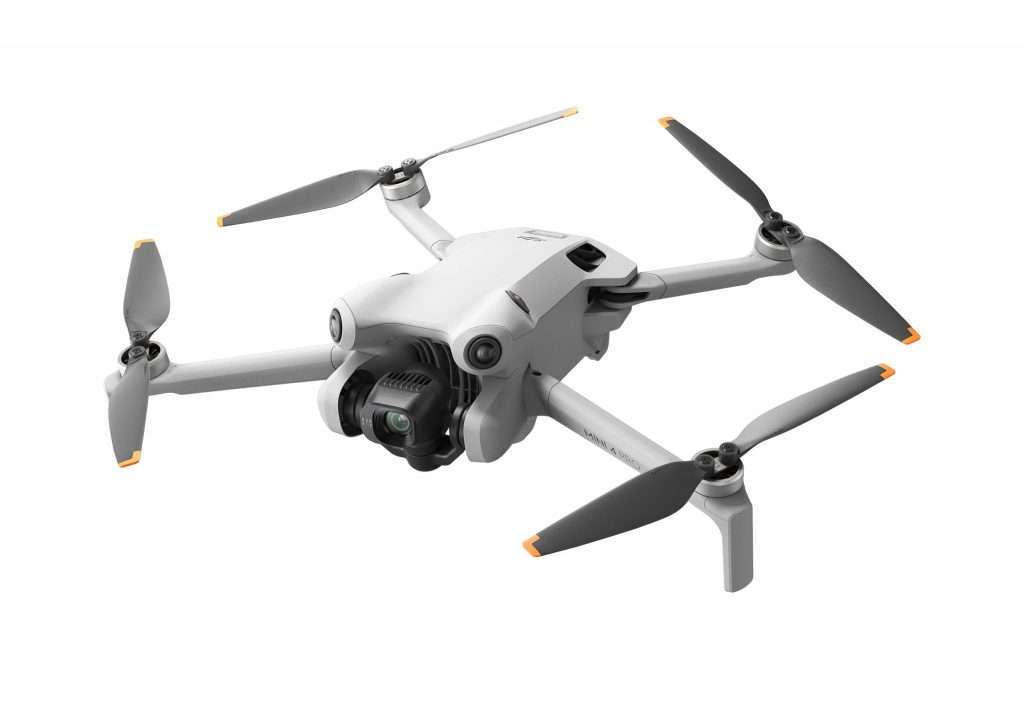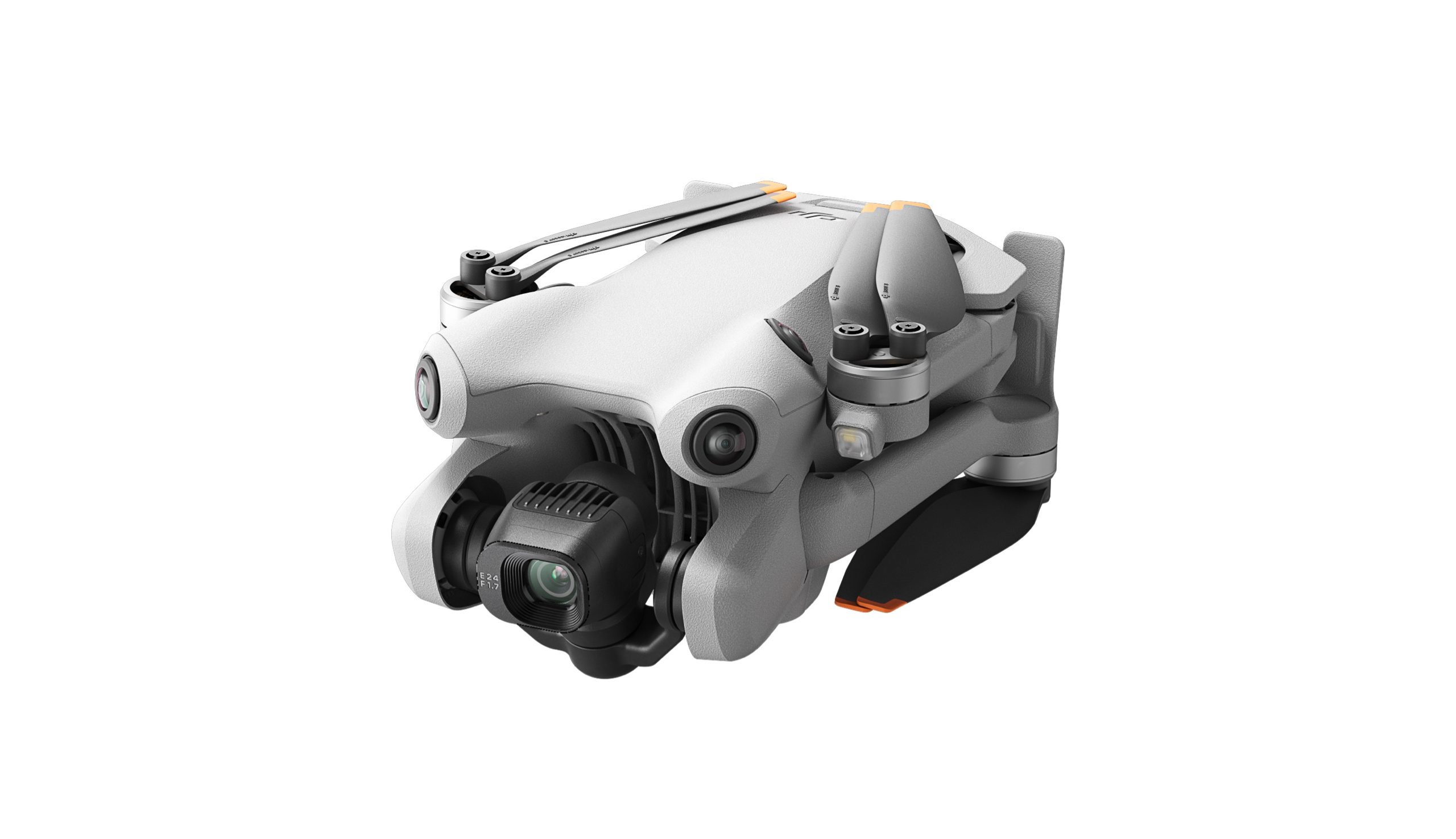The Mini 4 builds on the popular Mini series of drones from DJI. These ultra small, ultra portable, and most importantly ultra lightweight drones are some of DJI’s most popular thanks to sitting below the threshold of 250g. While an in-depth commentary on drone laws under 250g is beyond the scope of this review, suffice to say, owning a drone below 250g opens up much more lenient flying restrictions.
The challenges of squeezing this much tech into a body this small and light aren’t to be sniffed at, but DJI are absolute masters of the craft.
They take a considered approach to design, and use lightweight materials to offer a drone that is still very much DJI, with all the features we have come to expect.
As a result of this attention to design detail, the DJI Mini 4 Pro fits in the palm of the hand when folded, which also means it’s brilliant for slipping into a large coat pocket, or backpack when you’re on the move.
Unfolded, the drone will fit on an A4 piece of paper, making it super easy to deploy from most locations too.
There are no bells and whistles as such on the body of the Mini 4 Pro, just an on/off button, a slot for an intelligent battery, another for a micro SD card, and a USB-C socket.
Aside from that, you have the lenses for obstacle avoidance and of course the camera, mounted on a gimbal.
This keeps everything sleek, purposeful and lightweight.
A slightly chunkier form factor is used on the controller, whether the RC-N2 or the RC2, which has its own integrated screen. Both have decent ergonomics, but we would highly recommend investing in the RC2 controller with its integrated 700 nit, 5.5” display running an android operating system. The convenience of having an integrated screen, rather than connecting to your smartphone is not to be overlooked.
DJI Mini 4 Pro Flying
Flying the Mini 4 Pro is easy, even for an absolute beginner. DJI’s Fly app is the main interface between controller and drone, allowing you to monitor vital statistics, adjust your camera settings, and of course see the view from your drone.
You can access advanced settings for the drone, controller, gimbal, and camera from the screen allowing you to endlessly tweak and customise your experience, but for beginners the Mini 4 Pro comes out of the box in a ready to fly state.
The controller connects quickly, acquiring satellites for stable flying in less than a minute in our experience. Starting the drone itself is easy, simply pull both sticks towards you diagonally, and once again and the props start spinning. From there it’s a case of pushing the left stick upwards to lift off. Once in the air, you quickly realise just how quiet the Mini 4 Pro is, especially compared to a drone like the Mavic 3, with its much larger form factor. In fact, once you’re at an altitude over about 20m the Mini 4 Pro is barely audible making it a much better option if you’re trying to minimise your impact on your surroundings.
In flight the Mini 4 Pro is as stable as you would expect from a DJI drone. It suffers a little more in the wind than larger, heavier DJI drones, but that’s to be expected. We would say anything more than light gusts and you’re best packing the Mini 4 Pro away. The drone puts up a valiant fight with winds up to around 25 MPH, but beyond that the props struggle to balance the drones lightweight body.
Given a relatively calm day though, the Mini 4 Pro is an absolute joy to fly. It’s stable, responsive, and adaptable from beginner to pro.
It’s speedy enough for most video and photography applications, hitting a max of 26 MPH in N, or normal mode, and 35 MPH in sports mode.
The controls in the out of the box configuration can feel a little jittery but a quick flick of the mode switch to ‘C’ will see things slowed down and smoothed out for those buttery smooth shots. Switch to ‘S’ mode if you’re looking for maximum attack, but be aware that in sports mode the obstacle avoidance sensors are automatically turned off.
Battery life is claimed to be 34 minutes but in our testing we reckon a more realistic figure is closer to 20-25 minutes. This varies depending on conditions, the colder and windier it is, and the harder you fly it, the shorter the battery will last. The Mini 4 Pro comes as standard with one battery, grab yourself the Fly More Combo, with its two additional batteries and handy charging hub, and you’ll have enough batteries for long stints on the sticks.
Safety features are excellent in the Mini 4 Pro, with 360 degree obstacle avoidance, and accurate return to home. The obstacle avoidance system utilises tiny cameras around the drone to spot objects and then warns you of their proximity on the controller screen through an audible beep and visual indicator. If you get too close to the obstacle, the drone will either stop or attempt to avoid it. This system isn’t a 100% failsafe but it gets you out of most sticky situations and in general is an excellent feature to have, especially on a beginner friendly drone.
As with most features on the DJI Mini 4, obstacle avoidance can be tweaked to your liking, or turned off if you’re looking to do close quarters flying without interruption from the built-in computers.
DJI Mini 4 Pro Photography and Video Features
DJI’s Mini drones are renowned for packing a punch when it comes to video and photography considering their small form factor.
The Mini 4 Pro uses the same 1/1.3-inch sensor as the Mini 3 Pro so only shows minimal upgrades over its predecessor, boasting 4k shooting at up to 100fps for slow motion capture and up to 200fps in FHD. The only other notable change is the ability to shoot in the flat D-Log M colour profile, a boon for pro shooters and an improvement on the Mini 3’s Cinelike-D. These feel like very incremental gains and most likely won’t persuade many Mini 3 owners to upgrade.
The gimbal retains the ability to quickly flip into portrait mode which is super handy for social first shooters. This can be done at the press of a button while in the air.
If you’re looking for auto flight modes you’re in luck with the Mini 4 as it boasts a range of handy features to get the shot without the need for advanced skills. These include Active Track, where the drone can recognise, and then track a subject while you film or photograph. Quickshots modes include Dronie, Rocket, Circle, Helix, Boomerang, and Asteroid. These all essentially automate popular drone filming movements. For a completely automated shoot select Mastershots in the video menu, select your subject and let the drone do its work, moving around the subject filing a variety of different shots. The app can even do the editing of the final output for you using pre-defined templates.
As with most DJI drones, the Mini 4 takes excellent pictures when you consider the sensor size. The 12MP resolution is plenty for most casual and even some pro applications and the Quad Bayer sensor allows you to output 48MP, although this uses fancy trickery to boost the pixels making some pro shooters consider this particular feature a gimmick.
The 12MP mode gives you plenty of latitude for editing in post using the raw mode, and has an optional exposure bracketing feature to give you more dynamic range by capturing three photos at different exposure levels which you then blend together in post production.
Other creative photography options are available including panoramas and 360 photos which can look amazing from the air.
DJI RC2 Controller
The RC2 controller on the other hand has a much more worthy upgrade. The RC1 controller utilises internal antennas and these are prone to getting blocked by the users hands, which in turn blocks the signal getting to the drone.
The RC2 controller utilises external folding antennas, these are a much more sensible option as the signal is very rarely blocked by the users hands. In addition to the better antenna set-up, the RC2 controller has been upgraded from O3, to O4 transmission. This gives a much clearer signal, especially when there are obstacles between the controller and the drone.
Conclusion and final thoughts
Overall, the Mini 4 Pro is a rock solid drone that packs fantastic visuals into a tiny form factor. It is THE drone to have if you’re looking to capture great content in a highly portable form factor. Battery life is decent, as is transmission reliability, especially with the upgraded O4 transmission system and retractable antennas. In short, if you’re looking for a drone under 250g, then the DJI Mini 4 Pro is the way to go.






